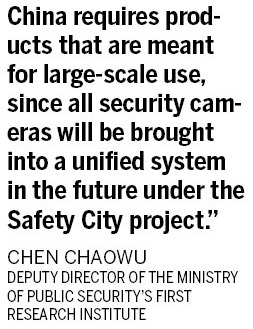 |
|
|
|
|||||||||
Sales in the Chinese surveillance market are forecast to reach 500 billion yuan ($78 billion) by 2015, showing a growth of 20 percent year-on-year. A restructuring of the industry is expected to accelerate that expansion, according to a development plan for the security and protection industry that was included in the 12th Five-Year Plan (2011-15), Jin said.
Almost all of the security cameras used in the Safety City project were made in foreign countries. According to a report in the Wall Street Journal in May, Cisco Systems has sold half a million cameras to Southwest China's Chongqing municipality to help the city bolster its security.
"The US has prohibited the export of crime-control products to China such as fingerprinting equipment," the report said. "But the US restrictions don't prohibit the sale of technologies, such as cameras, that can be used in many ways."
|
|
 |
|
|
Sales of video surveillance cameras make up a large part of the market for security equipment in China. The value of the country's output of such equipment, meanwhile, is expected to double in the next two years from 22 billion yuan in 2010, according to Frost & Sullivan.
Many international surveillance companies are aware of the existence of China's new standard, but none has released plans to make products that use it.
Tyco Fire & Security, a business segment of Tyco International Ltd and the largest provider of fire and security products and services in the world measured by sales revenue, also participated in the Chongqing Safety City project. The company, which is registered in Switzerland, provided the city with monitoring software derived from its personal security system.
"From door access control to intrusion monitoring, it can be simply long-distance controlled by your iPhone," said George Oliver, company president.
He said the technology will only be for commercial use and that he will not let governments influence the business.
The company has moved into China's petrochemical, banking, railway and electricity industries, Oliver said.
Canon and Panasonic said they are aware of the new SVAC standard but do not have products that have been set up in accordance with it. The two companies are working to supply equipment for the Safety City project and will consider using the standard if a strong demand arises for products that operate on it, Canon and Panasonic said.
Hideki Ozawa, president of Canon China, announced earlier that the company plans to introduce its first video surveillance products to China. The Japanese company said its target is to command 30 percent of the Chinese market for such products within five years.
Chen Yongmin, product manager of security systems for Panasonic China, said: "All of our products use the H.264 standard, and we occupy about 50 percent of China's video surveillance market in the banking industry."
Panasonic's biggest security camera plant is in Suzhou, Jiangsu province, and employs about 160 people.
"Overseas video-compression formats aren't suited to China's situation," said Chen from the Ministry of Public Security. "China requires products that are meant for large-scale use, since all security cameras will be brought into a unified system in the future under the Safety City project."
To help promote the domestic standard, an SVAC alliance was set up in August last year. The alliance has received support from various government departments, including the Ministry of Public Security, the Ministry of Industry and Information Technology, the Ministry of Science and Technology, the National Development and Reform Commission and the Standardization Administration of China.
Although it is not mandatory that those in the industry apply the standard, it will be adopted by government departments for use in public projects, said Jin at Vimicro. He also said the company will start to make products based on the new standard in 2012.
Since China takes up so large a part of the world market for surveillance, SVAC may spread to other places quickly if it becomes popular in its country of origin, Jin added.
In 2010, the Chinese security industry's output had a value of more than 230 billion yuan, and about 25,000 companies in the industry employed about 1.2 million people, according to statistics from the China Security and Protection Industry Association.
tuoyannan@chinadaily.com.cn